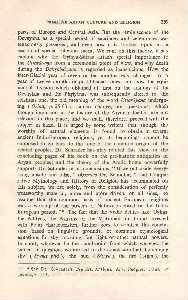Page 578 - Lokmanya Tilak Samagra (khand 2)
P. 578
PIUMITIVE ARYAN CULTURE AND RELIGION 359
parts of Europe and Central Asia. But the reminiscence of the
Devayana as a special period of sacrifices and ceremonies was
tenaciously preserved, and even now it is looked upon as a
season of special religious merit. We can, on this theory, easily
explain why the Qrihya-Sutra attach special importance to
the UttardyOIJa from a ceremonial point of view, and why death
during the Dak~hi~1ayana is regarded as inauspicious. How the
inter-Glacial year of seven or ten months was changed to a
year of twelve months in post-Glacial times, and how the equi·
noctial division which obtained at first on the analogy of th6
Devayana and the Pit#yana, was subsequently altered to the
solstitial one, the old meaning of the word UttardyQf}a undergo-
ing ( Orion, p. 25 f) a similar change, are questions, which
though important in the history of the Aryan calendar, are not
relevant in this place; and we shall, therefore, proceed with the
subject in hand. It is urged by some writers that though the
worship of natural elements is found to obtain in several
ancient Indo-European religions, yet its beginnings cannot be
supposed to go back to the time of the common origin of the
related peoples. Dr. Schrader has ably refuted this view in the
concluding pages of his book on the pre-historic antiquities of
Aryan peoples; and the theory of the Arctic home powerfully
supports Dr. £chrader in his conclusions. " If we put aside every-
thing unsafe and false, " observes Dr. Schrader, " that Compa-
rative Mythology and History of Religion has accumulated on
this subject, we are solely, from the consideration of perfectly
trustworthy material, more and more driven, on all sides, to
assume that the common basis of ancient European religions
was a worship of the powers of Nature practised in the Indo-
European period. "* The fact that the Vedic deities like U~has
the Adityas, the Ashvins or the Vritrahan are found invested
with Polar characteristics, further goes to confirm the conclu-
sion based on linguistic grounds, or common etymological
equations for sky, morning, fire, light or other natural powers.
In short, whatever be the stand-point from which we view the
subject in question, we are led to the conclusion that the shining
sky , ( Dyaus pita ), the sun ( Surya ), the fire ( Agni ), the
• See Dr. Schrader's Pre-His. Antiqui. Ary. People>, trans. b!'
Jevons, p. 418.

